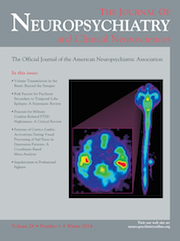Pisa Syndrome Induced by Paliperidone
To the Editor: Pisa syndrome, or pleurothotonus, is one type of the atypical extrapyramidal syndromes, which was first described by Ekbom et al. in 1972 and is characterized by tonic lateral flexion with slight rotation of the trunk and is worse while the patient is walking.1 Pisa syndrome could be induced by treatment with current atypical antipsychotics; however, no previous report has shown it to develop after paliperidone administration. We present a case of paliperidone-induced Pisa syndrome.
Case Report
An 18-year-old man with a 3-year history of schizophrenia, paranoid type, was treated with paliperidone 12 mg qd for 12 months. His psychotic symptoms included auditory hallucinations, religious delusions, and hallucinatory behaviors such as wandering outside in response to commanding voices. He responded well to the treatment but, after about 12 months, was found to have a dystonic syndrome with truncal rigidity and flexion to the right, especially while walking. At school, he had frequent falls resulting in abrasions. The patient was indifferent to the posture. He was admitted to our inpatient ward for further work-up. The possibility of conversion or catatonia was excluded. His complete blood count, serum biochemistry, thyroid function, chest roentgenogram, and brain MRI showed no significant findings. His Pisa syndrome disappeared after the paliperidone was switched to aripiprazole 5 mg bid gradually over 1 week, and trihexyphenidyl 4 mg/day was added. The patient was discharged 12 days later without the axial dystonia. His psychotic symptoms are well controlled by the current treatment.
Discussion
Although the mechanism for Pisa syndrome is unclear, it is thought to be related to dopaminergic-cholinergic imbalance in the brain or a possible dysfunction of other neurotransmitters, such as serotonin or norepinephrine. Forty percent of cases responded to anticholinergic drugs; in non-responders, the symptoms subsided while antipsychotics were being tapered or withdrawn.2 In our case, the patient’s physical symptom of truncal deviation to the right occurred after 12 months’ administration of paliperidone 12 mg qd. We chose not to challenge the patient with the previous regimen to observe whether his symptoms would reoccur. In this case, discontinuing the antipsychotic and adding an anticholinergic was an effective treatment for the Pisa syndrome.
Paliperidone (9-hydroxy-risperidone) is a metabolite of risperidone, with similar actions, in that it occupies both D2 and 5HT2A receptors. It also blocks α1- and α2-adrenergic receptors, as well as H1 histamine receptors. The most common adverse effects include extrapyramidal symptoms such as akathisia and parkinsonism, which develop at higher rates with increased doses (more than 6 mg daily).3 No previous case of Pisa syndrome has been reported after long-term treatment with paliperidone.
We changed the antipsychotic to aripiprazole as several case reports have shown that Pisa syndrome improved after aripiprazole treatment.4 It has been postulated that the D2 partial agonism of aripiprazole reduced D2 receptor hypersensitivity and improved dopaminergic–cholinergic imbalance; however, one case report showed that Pisa syndrome developed with a treatment combination of clozapine and aripiprazole.5 In our case, the patient’s Pisa syndrome subsided after the switch of antipsychotics to aripiprazole.
In summary, we suggest that Pisa syndrome is likely related to dopaminergic–cholinergic imbalance in the brain, with possible cholinergic dominance. To the best of our knowledge, this is the first case report of paliperidone-induced Pisa syndrome.
1 : New dystonic syndrome associated with butyrophenone therapy. Z Neurol 1972; 202:94–103Medline, Google Scholar
2 : Drug-induced Pisa syndrome (pleurothotonus): epidemiology and management. CNS Drugs 2002; 16:165–174Crossref, Medline, Google Scholar
3 : Efficacy and tolerability of oral paliperidone extended-release tablets in the treatment of acute schizophrenia: pooled data from three 6-week, placebo-controlled studies. J Clin Psychiatry 2008; 69:817–829Crossref, Medline, Google Scholar
4 : Improvement in Pisa syndrome and tardive dyskinesia following aripiprazole treatment. J Neuropsychiatry Clin Neurosci 2009; 21:350–351Link, Google Scholar
5 : Drug-induced Pisa syndrome associated with aripiprazole during clozapine treatment. Prog Neuropsychopharmacol Biol Psychiatry 2010; 34:707–708Crossref, Medline, Google Scholar



